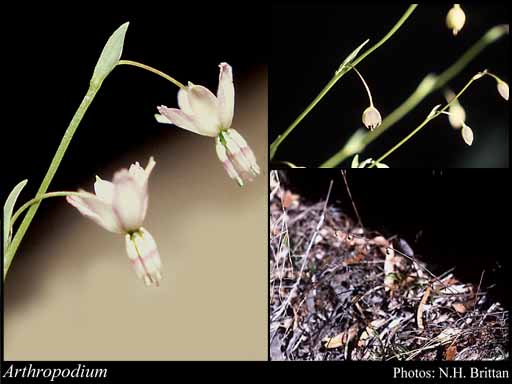- Reference
- Prodr.Fl.Nov.Holland. 276 (1810)
- Name Status
- Current

Scientific Description
Family Anthericaceae.
Sometimes included in Liliaceae.
Habit and leaf form. Herbs (tufted); evergreen, or deciduous. Perennial. Leaves basal, or cauline. Plants with a basal concentration of leaves, or with neither basal nor terminal concentrations of leaves; rhizomatous, or tuberous. Self supporting, or climbing. Mesophytic, or xerophytic. Leaves alternate (crowded, few to many at the base of the stem); spiral, or distichous; ‘herbaceous’, or leathery, or membranous; sessile; sheathing. Leaf sheaths not tubular; with free margins. Leaves edgewise to the stem, or with ‘normal’ orientation; simple. Leaf blades entire; flat, or folded, or solid (or triquetrous); linear, or lanceolate, or oblong, or ovate; linear (grass-like); parallel-veined; without cross-venules; sheathing, scarious. Leaves ligulate, or eligulate; without stipules. Leaf blade margins entire. Leaf anatomy. Hairs absent. Extra-floral nectaries absent. Stem anatomy. Secondary thickening absent.
Reproductive type, pollination. Fertile flowers hermaphrodite. Unisexual flowers absent. Plants hermaphrodite. Floral nectaries present. Nectar secretion from the gynoecium (from septal nectaries).
Inflorescence and flower features. Flowers aggregated in ‘inflorescences’; in racemes, or in panicles. The terminal inflorescence unit cymose, or racemose (simple or compound). Inflorescences scapiflorous; terminal; with involucral bracts, or without involucral bracts; pseudanthial, or not pseudanthial. Flowers pedicellate (erect, spreading or nodding, articulate or not articulate, filiform); bracteate (1 subtends each branch and each pedicel or group of pedicels, inconspicuous, scarious); bracteolate (when more than 1 pedicel very small bracteoles enclosed in bract); small, or medium-sized; regular (inflorescence 1–9 per node, secund or not secund; simple to much branched); 3 merous; cyclic; pentacyclic, or tetracyclic. Perigone tube absent. Perianth with distinct calyx and corolla (the whorls rather different), or of ‘tepals’; 6; 2 -whorled (3+3); isomerous; free; petaloid; similar in the two whorls, or different in the two whorls; white, or purple, or blue (pale). Perianth members fringed (inner segments, or crisped or not crisped), or entire (outer segments, or undulate). Calyx (if the outer whorl so interpreted) 3; 1 -whorled; regular. Corolla (if the inner whorl so interpreted) 3; 1 -whorled; regular. Corolla members sometimes fringed, or . Androecial members definite in number. Androecium 6. Androecial members free of the perianth, or adnate (to the perianth); all equal; free of one another; 1 -whorled, or 2 -whorled. Androecium exclusively of fertile stamens, or including staminodes. Staminodes when present, 3. Stamens 6; all more or less similar in shape; isomerous with the perianth, or diplostemonous; at the base of the perianth segments, almost hypogynous; alterniperianthial, or oppositiperianthial. Filaments appendiculate (attached to both anther and filament); hairy. Anthers basifixed; dehiscing via longitudinal slits; introrse; tetrasporangiate. Gynoecium 3 carpelled. The pistil 3 celled. Carpels isomerous with the perianth. Gynoecium syncarpous; synstylovarious, or eu-syncarpous; superior. Ovary plurilocular; 3 locular; sessile. Gynoecium stylate. Styles 1; apical. Stigmas 1; 2–3 - lobed. Placentation axile. Ovules 1–5 per locule (or 8–12); arillate, or non-arillate; campylotropous (generally), or anatropous.
Fruit and seed features. Fruit non-fleshy; dehiscent; usually a capsule. Capsules loculicidal. Fruit 3 celled; few per locule. Seeds endospermic. Cotyledons 1. Embryo straight to curved.